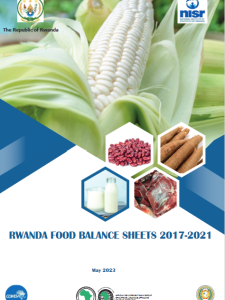
Rwanda Food Balance Sheets 2017-2021
The Food Balance Sheets (FBS) 2017-2021 report presents a comprehensive picture of the patterns of Rwanda's food supply and utilization in Rwanda between 2017 and 2021. The compilation of the FBS 2017-2021 follows the international standard guidelines, which are reviewed and updated under the Global Strategy for Improving Agriculture and Rural Statistics.
The FBS report provides information on national food supplies, which are summarized as Total Supply (Domestic production plus Imports less Exports, and stock variation), and Total Utilization (Processed products, losses, feed, seed, food, and other uses). It also provides information on per capita supply in terms of quantity (annual food in kilograms) and daily food availability in terms of nutrient values (calories, fats, and protein). The FBS data also assist in determining whether a country is self-sufficient or reliant on imports to feed its population. Furthermore, the FBS can be utilized to measure and monitor progress of food security indicators related to the Sustainable Development Goals (SDGs), specifically the Prevalence of Undernourishment (PoU) and the Food Loss Index (FLI).
The FBS results for Rwanda reveal that vegetable products are the primary sources of the population's daily food, contributing 98 percent of the total dietary energy supply (DES) between 2017 and 2021. Vegetables include all food items except animal products. Starchy roots, cereals, and pulses are the largest contributors, accounting for 75 percent of the vegetable products. Furthermore, the results indicate that Rwanda maintains a high level of self-sufficiency; however, additional imports are still necessary to meet domestic demand. Approximately one-third of the food commodities used are obtained through imports.
Overall, food balance sheet results serve as a crucial tool for policymakers, researchers, and organizations involved in food security, nutrition planning, and agricultural development, enabling evidence-based decision-making and targeted interventions to address food-related challenges.
| File | Download Count |
|---|---|
| 346 |
